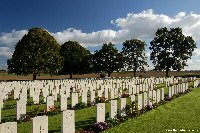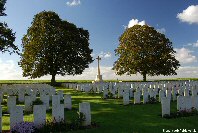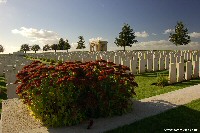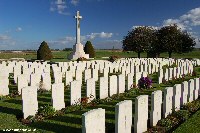Courcelette
The World War One Battlefields site is undergoing a major update, with pages being converted to a new, user-friendly mobile format. The updated pages can be found at Updated World War One Battlefields. Some pages such as this one remain in the original format pending update.
Courcelette is found just to the north of the main D929 road between Albert and Bapaume. At the beginning of the Somme Battles in July 1916 this village was well within German held territory, and it was not until mid-September that the British reached this far. On the 15th of September 1916 the offensive which was to be known as the Battle of Flers-Courcelette was launched, which was on a wide front and involved the first use of tanks. At Courcelette, it was the Canadians who attacked and some more information on this is given further down on this page. After its capture, Courcelette remained near the front lines until the Germans withdrew to the Hindenburg Line early in 1917, but it was taken again in their Spring Offensive on the 25th of March 1918. It was five months later before the British retook it as they advanced in the final few months of the War.
On the left side of the main road heading towards Bapaume is Coucelette Canadian Memorial. This is a busy road, but there is plenty of space for parking by the memorial, although the camber is a little steep. The memorial is set within a small park, similar to several other Canadian Memorials on the Western Front such as at Hill 62 in Flanders and at Bourlon Wood near Cambrai.
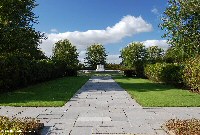
The Canadian Memorial Park at Courcelette
As at other Canadian Memorials, arrows set in the paths point to local landmarks, which here include the nearby village of Coucelette, as well as Bapaume and others. The lawns and grounds are immaculate and the memorial itself is in the form of a stone set right in the centre, surrounded by pathways. The inscription commemorates the Canadians part in breaking the German lines from the 3rd of September to the 18th of November 1916.
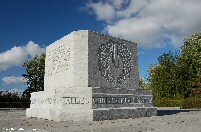
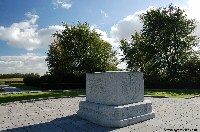
The Canadian Memorial at Courcelette
A left turn just after the Canadian Memorial leads towards the village itself. There are a number of cemeteries near Courcelette. To the west of the village is Courcelette British Cemetery, up a small track which is passable by car although the surface is not the best. The cemetery was started in November 1916, and originally was known as Mouquet Road or Sunken Road Cemetery. It was used until the German lines withdrew in Spring 1917. By that stage there were 74 burials here, and these now form part of Plot One (Rows A to F).
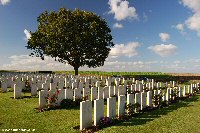
Original graves at Courcelette British Cemetery
Nearly 1,900 more graves were brought in to the cemetery after the Armistice, most of these being from near here and around Pozieres. At least two other small cemeteries were concentrated here - Mouquet Farm Cemetery and Red Chateau Cemetery, which was in Courcelette and described as being 'at the entrance to a ruined dug-out'. The total number of burials and commemorations now is 1,970; nearly 60% of these are unidentified.
Most of the graves were moved here from elsewhere, and in some cases archive records show where these men were originally buried. For example, Serjeant Charles Fowler Murrell, an Australian, was originally buried 'on the oppositte side of road from Cemetery Post near Pozieres just over 3 miles N.E. of Albert'. A later note confirms he was reburied in Courcelette British Cemetery, which must have been by November 1919 as a note was sent to his mother at that time confirming this as his final resting place. His mother, Mrs. M. Murrell asked for the return of the wooden cross that had originally marked his grave, but was told by the authorities in 1920 that this was not possible due to the likely state of disrepair of the cross and the difficulty in shipping this from France. The letter implies that this was a general policy for Australians, although in many cases families in Britain could and did recieve the wooden crosses when these were replaced with headstones, and some of these original crosses can still be seen in various churches around Britain today.
To the north-west of the village at the end of a track is Regina Trench Cemetery, the name coming from a trench which ran to the north of Courcelette, roughly in an north-east to south-west line.
To the north of the village on the D107 road towards Miraumont is Adanac Military Cemetery. Regina Trench crossed the road a little to the south of the cemetery, and Courcelette Trench ran on the other side of the road from the cemetery, more or less following the line of the road. A Maple Leaf motif attached to the gates denotes the Canadian associations of this cemetery, the name being 'Canada' spelt backwards. It was made after the Armistice around a single existing grave in Plot 4, Row D, Grave 30, and now is a large cemtery; over 3,000 are buried here, around a third of whom are Canadian. It contains many graves of soldiers who fell in the battlefields around Courcelette, and also from a number of other cemeteries nearby which were concentrated here.
Today, the cemetery is open fronted to the road, but there used to be a wall at the front, as can be seen in an early postcard of the cemetery shown below. Compared with the modern view beneath, there are still a few crosses rather than headstones to be seen, suggesting that the postcard photograph was probably taken in the 1920s. Trees at the front of the cemetery now block the view to the left, but the small bushes at the end of each row of graves look almost the same today as they did then. One other change is that the name of the cemetery on the right gatepost is now inscribed in French.
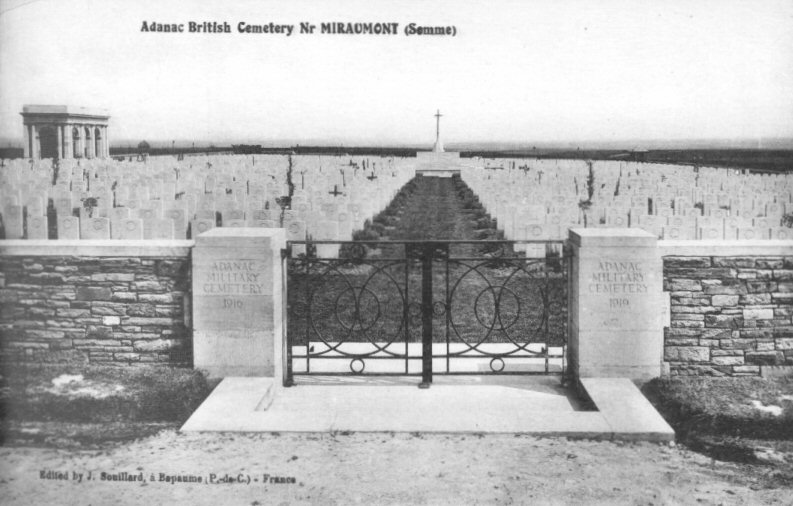
Adanac Cemetery between the Wars. Photo: J. Souillard
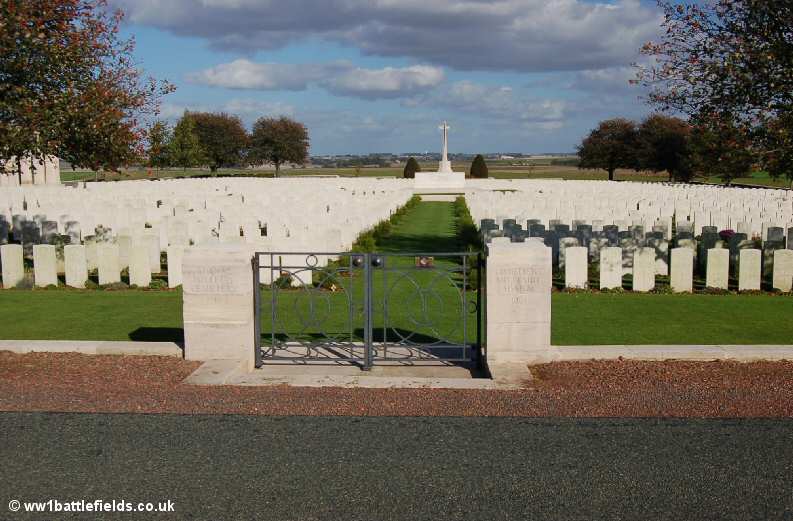
Adanac Cemetery today
Some interesting entries can be found in the register, and often these contain more detail than the online CWGC records. For instance, Lance-Corporal Reginal Ronald Thompson Doherty of the 102nd Battalion of the Canadian Infantry is described as 'killed in action at Regina trench' on the 11th of November 1916. He was from Vancouver, although had been born in Liverpool, England where his parents still lived. He was an accountant, married and 47 years old when he died here on the Somme. The War Diary of the 102nd Brigade records that on the 10th of November 1916 there was a heavy bombardment of Regina Trench. Early in the morning of the 11th, there was a German counter-attack, and Lieutenant Lieter of 'A' Company was sent with reinforcements to support those in Regina Trench. There were more counter-attacks until dawn, but the position was held, although 18 had been killed including Doherty.
Another Canadian buried here is Corporal Eugene Langevin from Montreal, who died serving with 'A' Company of the 22nd Battalion on the 17th of September 1916. The register records he was killed in action at Courcelette. The 22nd Battalion only arrived in the Somme area on September the 10th, and was in the line by the 15th, part of the Canadian force which attacked Courcelette at 6.00 p.m. The village was taken, and the batallion then beat off seven counter-attacks that same night. On the 16th they held off four counter-attacks, and on the 17th of September two more were repulsed. It was on this day that Eugene Langevin was killed. The battalion was relieved the next day.
The 22nd Battalion were involved again in action a few days later, and the Commanding Officer (Major A.E. Debuc) shortly afterwards wrote a report to sum up their experiences. This is interesting as it reflects thinking just a few days later, rather than a historical analysis from some years or decades distance. One section of this report states 'It is no easy matter to express opinions as to the lessons to be derived from the above operations, as the great majority of the actors were either killed or wounded'. Only four of the original eleven officers remained with the unit, and another comment in the report is 'On Oct 1st, three waves of one man per 5 yards in an 800 yards advance in the open against a strong and practically undamged trench like Regina was sheer suicide'. The difficulties of communications were also highlighted: 'Once the attack is launched the Battalion Commander is practically impotent......the trouble seems to be that casualties amongst officers are usually so large proportionately that nobody is left to send this information'.
Whilst the War Diary of the 22nd Battalion gives scant details of the September 15th attack on Courcelette, there is a full report in the War Diary of the 25th Canadian Battalion, who attacked to the left of the 22nd Battalion. The dividing line between them was the main village street, marked by the church steeple. The 22nd Battalion War Diary reports that as they advanced they came under 'very heavy rifle and machine gun fire and I found the enemy were in a hedge and the most southernly buildings of the village, so I gave orders to rush this hedge and buildings.......a great many enemy were killed here and a MG captured'. By now the 25th Battalion had advanced ahead of their own barrage, meaning they were at risk from their own shells, and so they halted for a while. The rather oddly phrased comment in the diary is that the troops at this point were 'as cool as cucumbers and as bright and keen as harmless babies'. By 6.25 p.m. they had taken the village and then dug in. After coming out of the line on the 18th, the 22nd Battalion reported 336 casualties and the 25th Battalion 258.
There are two Victoria Cross winners buried here; again one has an association with Regina Trench. This was Piper James Richardson, who enlisted in September 1914 and served with the 16th Canadian Battalion, although he was originally from Bells Hill, Lanarkshire in Scotland. On the 8th of October 1916 at Regina Trench his Company in the 16th (Canadian Scottish) Battalion was under intense fire, and held up by barbed wire. Richardson strode up and down outside the wire piping his Company forward, and they rushed and took the German position. Richardson was later sent back with a casualty and some prisoners, but returned when he remembered he had left his pipes behind, and was not seen alive again.
The other V. C. was won on the same day that Courcelette was taken for the second time by the Allies, the 24th of August 1918. It was won however at Grevillers, about four miles north-east of here. Serjeant Samuel Forsyth served with the New Zealand Engineers, but was attached to the 2nd Battalion when he won the V. C. for leading attacks on three German machine gun positions during an attack. He then tried to enlist the help of a tank, but was wounded and the tank also put out of action. He still went on, leading the tank crew as well as his own men in an attack on the enemy, but was then shot and killed by a sniper.
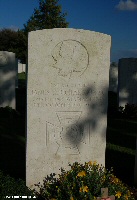
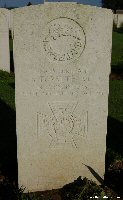
The graves of VC winners Piper James Richardson and Serjeant Samuel Forsyth
Sources & Acknowledgements
Australian National Archives
Commonwealth War Graves Commission website
Gerald Gliddon: Somme 1916
Major & Mrs. Holt: Battlefield Guide to the Somme
Chris McCarthy: The Somme - the day by day account
Martin & Mary Middlebrook: Somme Battlefields
Library and Archives Canada

